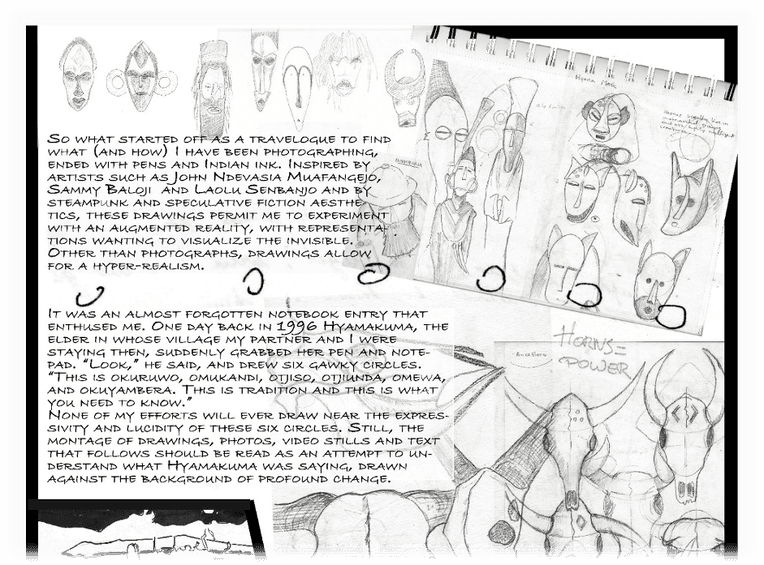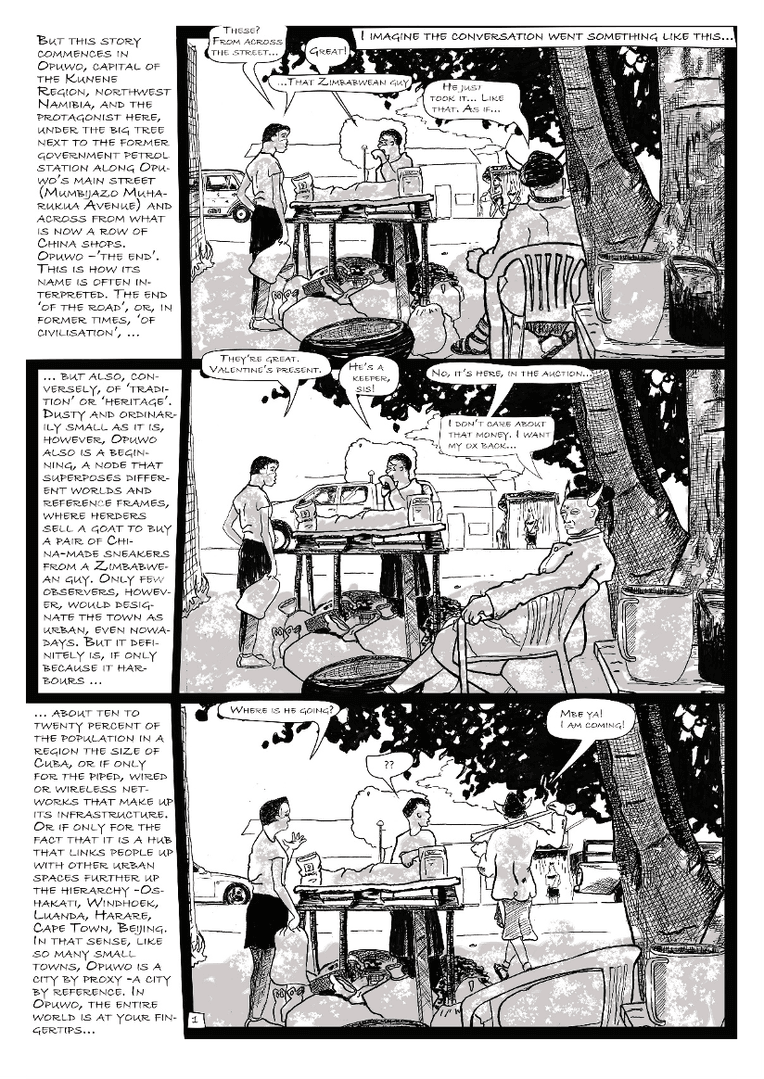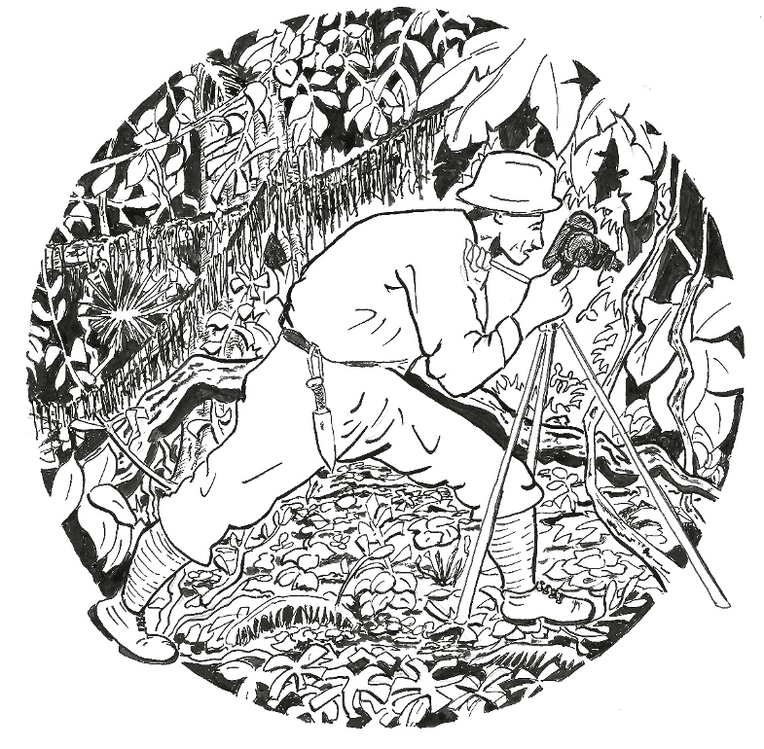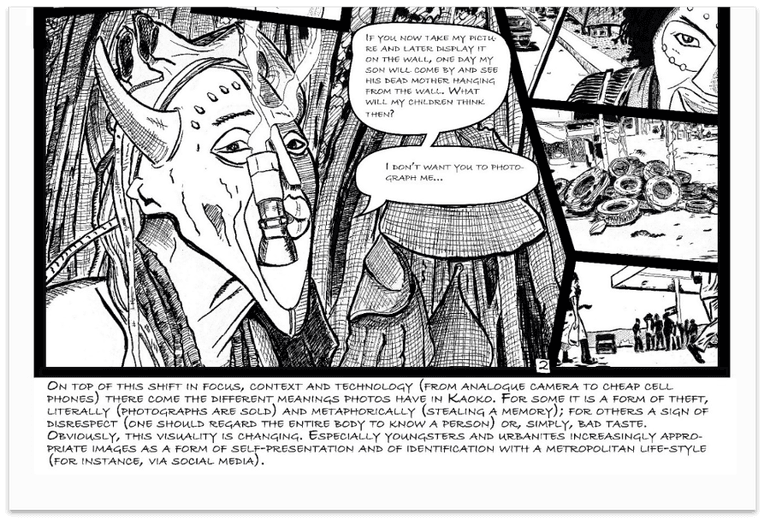Drawing Anthropology: A Couple of Things I Am Learning
From the Series: Graphic Ethnography on the Rise
From the Series: Graphic Ethnography on the Rise

In my early teens, I spent my entire allowance in the local comic book store. Then, at the age of sixteen, I discovered music and my interest in reading (and attempts at drawing) comic books dwindled.
Fast forward to 2016. Sitting in my office I was going through my notebooks, looking for that one little detail I needed to spice up the piece I was writing—I knew it was somewhere in there—when I stumbled upon a drawing by one of my participants.
This little drawing brought to life a quiet, hot Namibian afternoon. My partner and I were sitting in the shade with Hyamakuma, one of the elders in whose village we were staying at the time. He bore the reputation to be difficult, even though we felt he often played the role of grumpy old man, while—in fact—he had tons of humor and was, or could be, very cheerful. We were asking him question after question until he got annoyed, took my partner’s pen and notebook and drew six circles. He named them, concluded that this was all we needed to know, and made it quite clear he had enough and wanted to have a nap.

In the days or weeks following my notebook discovery I kept on thinking about what Hyamakuma had wanted to tell us. It dawned that he had outlined the contours of a moral universe, as all six circles he sketched involved the ancestors. I wanted to write “something” about this, but what? And, especially, how? Slowly I was drawn into nostalgia lane, remembered my old comic book collection which I had left behind when leaving my mother’s home. From under a pile of rubble and child’s toys I dug up my old drawing board. A lightbulb popped up: Why not make a comic?

Fast forward, again, to the present. I just finished the first draft of a third graphic project. It is a collaboration with Richard Ivan Jobs, Pacific University, on the “discovery of the last Mayans” by a French adventurer, Bernard de Colmont, in the 1930s. I now draw much more regularly and, much to my partner’s despair, I now again patronize the local comic book store. In the meantime, graphic anthropology has evolved into a modest hype, one that is much appreciated by students and colleagues. I still feel uncertain when it comes to my graphic and storytelling skills, but, if you allow me, I would like to share some of the things I am learning while scratching away in my basement. Bear with me.
The initial project (see Van Wolputte 2017a, 2017b) taught me that drawing is not just an alternative form of communicating, but (like all writing) also is a form of analysis that opens up new venues for thinking. For instance, because my interlocutors resented being portrayed, in “Six Circles” I used masking as a literary device, which led me into a reflection on dividuality and individuality, on the relational nature of “worlding,” and on masking as a more exciting way to think of what is commonly designated by outlived concepts such as “identity.” In short: masks do not hide our true self; it is through masking that others can relate to us, and we to them.
In a following project I wanted to illustrate how people in the small secondary town I work do not always (or even usually) follow the lines set out for them by architects, urban planners and city councils. Instead, they carve and follow their own desire paths. Rather than starting with satellite images or with a literature review on urban anthropology, I started the story with a car accident I happened to have witnessed, and tried to spin my analytic threads from there. Drawing thus made me tell different stories, and tell them differently: without this project, the incident on the streets of Opuwo would have remained an anecdote tucked away in my notes.

Collaborating with Richard Jobs on the life and works of Bernard de Colmont taught me to look at ethnographic practice in different ways. Apart from an exercise in storytelling, this ongoing project has also shown me the possibilities of the genre to combine or mash-up various sources into a single visual narrative. As a form of creative nonfiction, the graphic-ethnographic approach allows to combine various sources (in this case, transcripts from radio interviews, documentary films, and photographs from the 1930s) in what we hope is an appealing and comprehensive form, to critically discuss and show the ambivalences (the ambition to discover “lost worlds” to save them from oblivion combined with racist paternalism) that characterized 1930s European ethnography.

Graphic-ethnographic approaches (or graphic novels, in current lingo) are often seen as a great way to reach a broader audience, or to “give back” to one’s participants. One reason certainly is that comics do not like wordiness, and that one has to “de-literate” one’s findings or analysis. A common assumption is that images are a universal language. One of the greatest compliments I ever got was from an anonymous reviewer to my first published comic, who wrote that one of their kids confided that finally they understood what their parent’s research was about. But no: comics are not a universal language. European comics do not fare well in the United States, and vice versa; Japanese mangas are nowhere as big as in Japan. Visuality is a curious thing, and all too often taken for granted.


Usually I put on some music and use a technical pencil to sketch out individual frames. These pencil drawings are then inked using a dip pen, markers, brushes, and India ink. I use graphic software to make minor edits and to clean up the original drawing (even if I like to leave some of the pencil traces, as a kind of palimpsest) and, most importantly, combine these individual frames into pages; for this I work with various layers to sometimes combine actors and background, divide the page and add gutters, and add text. In that sense, this process of assemblage resembles a lot the making of a movie or animated film, as it involves editing, cutting up scenes, rearranging. I did see some great examples of digital artwork, but I happen to like the scent of India ink and the scratching sound of the pen on paper, the stained fingers; I like the idea that every stroke is definitive, and the happy accidents that occur along the way. I don't resent digital art (on the contrary, I have seen great examples of what it can do), and I do plan to explore its endless possibilities in the near future. But again, I like the irrevocability of ink, and the tension that comes with not wanting to fuck up.
Jobs, Richard I., and Steven Van Wolputte. Forthcoming. The Adventures of Count de Colmont: The Quest for the Last Mayans. Unpublished manuscript.
Van Wolputte, Steven. 2017a. “A Tale of Six Circles: A Travelogue.” Visual Anthropology Review 33, no. 2: 177–190.
Van Wolputte, Steven. 2017b. “Six Notes: Afterthoughts.” Visual Anthropology Review 33, no. 2: 191–194.
Van Wolputte, Steven. 2018. “Desire Paths.” Etnofoor 29, no. 2: 97–107.